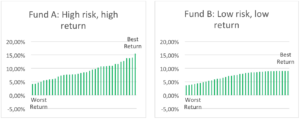
Investment risk explained
Bradley Kaplan is an investment specialist at Purple Group, one of South Africa’s top stockbroking companies and a client of CN&CO’s. Brad and his colleagues are really smart, and are able to describe quite technical things in simple terms. In this blog he demystifies the concept of risk in investment.
Risk, when associated with investments, is a word that no one enjoys hearing, especially when it is said by the person looking after your hard-earned money. Risk is the potential of gaining or losing something of value. When you seek assistance from a person to care for your money, just hearing the word “risk” may sound alarm bells.
Let’s begin by explaining what risk actually infers, and then focus on why it is not as bad as people perceive it to be.
What is risk?
Risk implies potential deviation from expected earnings or an expected outcome. In layman’s terms this means risk gives you an opportunity to make profit or loss in a situation and not a guaranteed return.
Three types of investors exist:
- Risk seeking
- Risk neutral
- Risk averse (the most common type of investor).
A scenario to demonstrate the difference between these three types of investors follows:
You are selected to play a game. Once you start, you are given two options, A or B.
Option A: You play a round of heads or tails. This gives you a 50% chance of winning.
If you win, you win R1000 ; if you lose you get nothing.
Option B: You don’t participate in the game of heads or tails and receive R500.
As you can see, both option A and option B have an expected payoff of R500
From the example of this game we can infer the following:
- The risk seeking individual will select option A. An investor who, when faced with two investments with the same expected return, will prefer the one with higher risk.
- The risk averse individual will go with option B. An investor who, when faced with two investments with the same expected return, will prefer the one with lower risk.
- And lastly, a risk neutral individual is indifferent and therefore has no preference for option A or option B.
What influences an investor’s risk tolerance?
The two factors that influence an investor’s risk tolerance are as follows:
- The ability to take risk
- The willingness to take risk
Your ability to take risk is determined by how much your investment can decrease before altering your standard of living. Your ability to take risk will increase as your financial position improves.
Your willingness to take risk is harder to determine as it is dependent on how you would feel if your investment went down by a certain amount. Your willingness to take risk may increase through education, confidence, experience and exposure to the risks.
How does risk relate to returns?
Let’s consider two portfolios, the first is Fund A: an equity portfolio (high risk and high return) and the second is Fund B: a fixed income portfolio (low risk and low return). See the distributions of one-year returns below:
One-year returns over the data collection period
A survey inclusive of a group of randomly chosen participants was performed to choose which fund they would be invested in after looking at the distribution of one-year returns for Fund A and Fund B. 
Fund A had a maximum one year return of 34.11% and a maximum loss of 38.49%.
Fund B had a maximum one year return of 13.98% and a minimum one year return of 1.76%.
40% of the participants chose to put their investment in Fund A and 60% chose to put it in Fund B.
The average annual returns over 20 years within the data collection period
A similar survey was performed with a different group of participants who possessed the same knowledge as the previous group. However, they were shown the distributions of average annual return over 20 years for Fund A and Fund B and not the distributions of one-year returns.
 Fund A had a maximum return of 15.41% and a minimum return of 4.08%.
Fund A had a maximum return of 15.41% and a minimum return of 4.08%.
Fund B had a maximum return of 8.99% and a minimum return of 3.59%.
The percent of participants that chose Fund A after seeing the average annual returns over 20 year was now 90% and only 10% chose Fund B.
What does this all mean?
When looking at returns over a short-term period, there is a higher chance that the results will differ from expected earnings or an expected outcome in a high-risk portfolio compared to a low-risk portfolio. This volatility is sometimes too much for an investor to withstand. Historically, equities have had a higher minimum and a higher maximum return compared to fixed-income returns as the investment time horizon increases, as seen in the experiment above.
Although equities have had higher returns historically, I am not implying that you should put all your investments in equities. Rather, it is my opinion that an investor should have a diversified portfolio comprising equities and fixed income products. This diversified portfolio helps the investor to receive a return on his/her investment closer to the expected return. It also gives him/her the opportunity to receive higher returns over a long-term period by adding fixed-income products and equity products respectively.
The general rule of thumb is: the percentage you should have invested in equities is 100 minus your age; therefore, a 30-year-old investor should have 70% in equities and 30% in fixed income. This might not suit all investors, but it’s the general rule.
Conclusion
Risk is not bad. In fact, if risk is taken in moderation it will assist in achieving financial independence sooner than expected. It is my opinion that all investors should diversify their portfolios and keep their investments time-horizon long enough to reap the benefits. As seen in the figures above, by increasing your investment time horizon you can consume more risk and increase your potential returns.
Let the compound returns of your investments work for themselves.
“Compound interest is the eighth wonder of the world. He who understands it, earns it. He who doesn’t, pays it”- Albert Einstein.






